Globular Cluster Messier 9 & Dark Cloud Barnard 64

Messier 9
Messier 9 is a small, bright globular cluster and was discovered in 1764 together with M 10, M 12 and M 14 within a few nights. Messier noted: «Nebula, without star, in the right leg of Ophiuchus; it is round and its light faint.» [281]
M 9 is the smallest cluster of this quartet. The most striking feature is its slightly oval shape and a small curved chain of six stars southwest of the centre (see Fig. 1). At the moment it is not known to the author whether this star chain belongs to M 9 or is only in the foreground. M 9 is relatively close to the central bulge of the Milky Way system. The calculated distance is given as about 7500 light years. For comparison: the sun is around 26'000 light years away from the galactic centre. The diameter of M 9 is around 60 light years and the total luminosity is estimated to be 60'000 times that of the sun, if one can assume that around half of the light is absorbed by interstellar matter in between. Strong absorption in the north and west suggests that the light is weakened by at least about one magnitude. Not surprising, since the sharply delimited dark cloud Barnard 64, which appears to be part of a larger complex of interstellar matter, is located close to M 9 in a westerly direction. The globular cluster moves away from us at a radial speed of about 225 km/s. [4]
| Designation | NGC 6333 |
| Type | GCL (VIII) |
| Right Ascension (J2000.0) | 17h 19m 11.8s |
| Declination (J2000.0) | -18° 30' 57" |
| Diameter | 12 arcmin |
| Visual magnitude | 7.8 mag |
| Metric Distance | 7.900 kpc |
| Dreyer Description | globular, B, L, R, eCM, rrr, st 14 |
| Identification, Remarks | h 1979=3677; GC 4287; M 9; GCL 60; ESO 587-SC5 |
Barnard 64
In 1919, Edward. E. Barnard discovered a cometary dark cloud west of M 9 in one of his photographs and listed it as B 64 in his publication «On the Dark Markings of the Sky». [239]
| Name | Barnard 64 |
| Object Type | Dark Cloud (nebula) |
| Right Ascension (J2000.0) | 17h 17m 24s |
| Declination (J2000.0) | -18° 31' 00" |
| Angular size | 6' × 7.8' |
| Identifiers | Barnard 64; LDN 173; TGU H63 P2; [CB88] 78 |
Finder Chart
The globular cluster Messier 9 is located in the constellation Ophiuchus (Serpent Bearer), roughly in the middle between the 2.43 mag bright star Sabik (η Ophiuchi) and the 4.39 mag bright star ξ Ophiuchi. It is best seen between May and July.
